The Citadel
Summary
The relaxation place instead of battle place
In the footsteps of the medieval castle
Adapting to new fortifications arms
An arsenal until after the Second World War
The relaxation place instead of battle place
The Citadel is also called "Memorial Stadium" because it was long a place of fierce fighting until the Second World War as we shall see later.
Today, the entire site was renovated to become a recreation area. Thus, it is possible to focus on a number of sports such as football or tennis in outdoor or indoor. There are various sports associations and a small stage open-access football.
But we can also decide to canoe quietly around the fortifications, stroll atop the fortifications or in the pretty square below situated opposite the main entrance to the east of the Gate of Neptune .. .
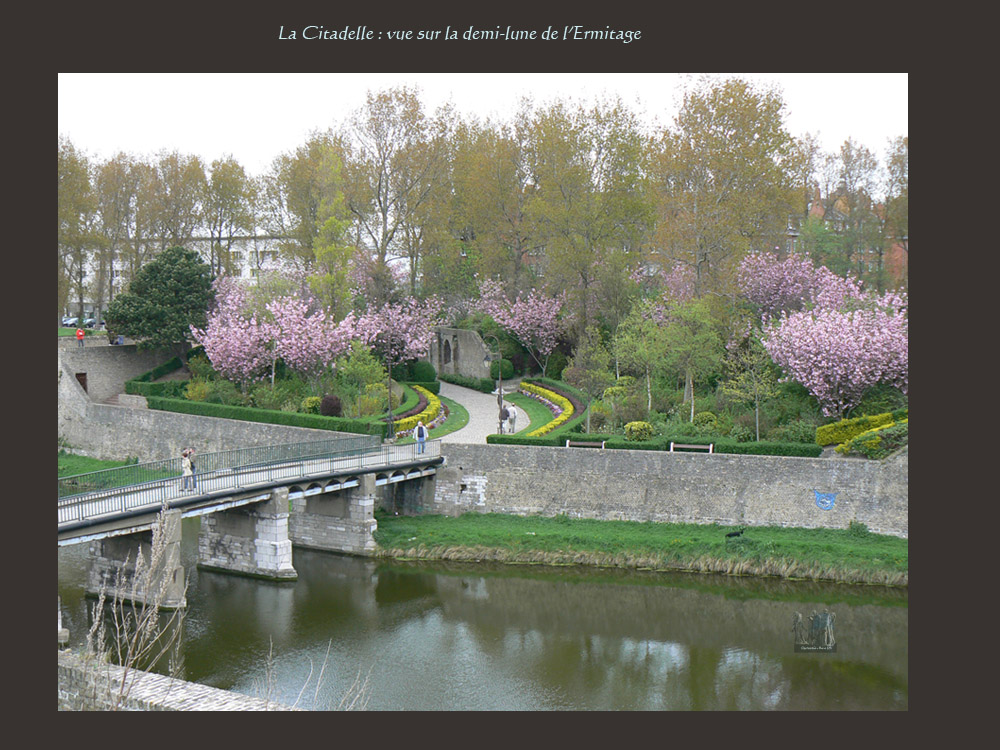
HALF MOON HERMITAGE :
It is indeed a defensive triangle built north of the Citadel, opposite the pits, following the Spanish occupation (1596-1598). It was intended to strengthen this entry considée as the weak point of the fort because it is from this side that the Spaniards managed to create a breach in the hollow and fragile walls, and to visit the proprietors.
In the footsteps of the medieval castle
The first built in Calais fortress was a castle in the Middle Ages. Its construction was not motivated by external threats to France, but directly related to problems of royal succession ... Indeed, the death of King Louis VIII, in 1226, leaves a son eleven years too young to reign. Therefore, his wife, Blanche of Castile, became regent but collides with a host of French lords ...
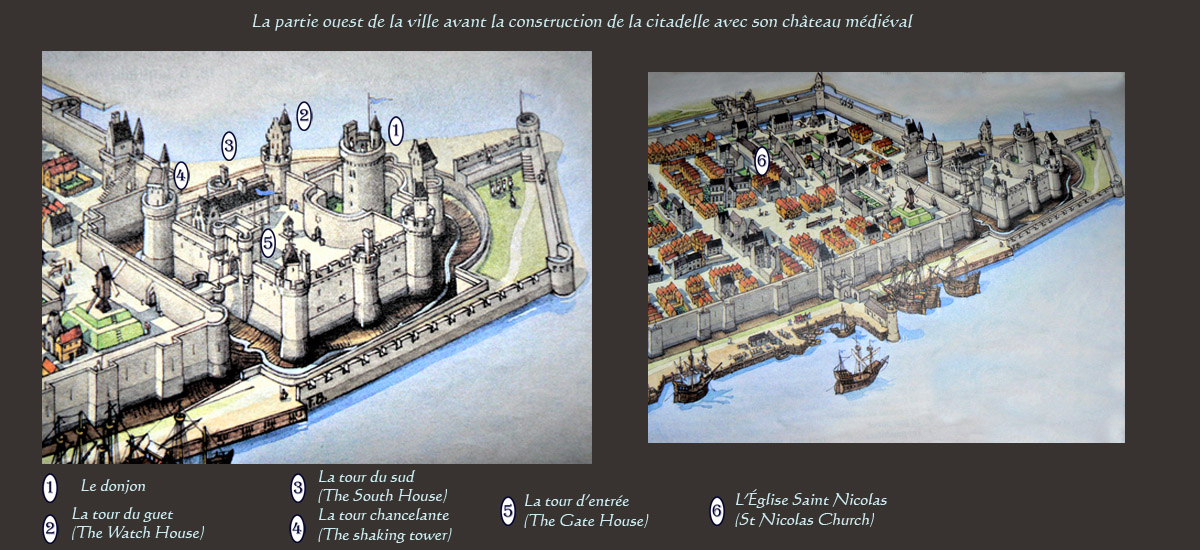
→ A castle for a rebel lord...
On the death of Louis VIII in 1226, Count Philippe de Hurepel disputed the regency entrusted to the mother of the young Louis IX (Saint Louis), Blanche of Castile, regent he wants to grab as (half) brother of the late king.
Feeling threatened, he decided to strengthen the defense of its territories, especially in Artois. So in 1228 he began building the first walls of Calais and the construction of a fortress northwest of the current citadel.
The castle has six cylindrical towers, three north and three south, and a dungeon. Towers allowed to order the curtains which were thick. Talutée the base of the towers function was to make ricochet projectiles and strengthen self-defense against undermining. A drawbridge gave access to the castle, which measured (excluding ditches) about one hectare (100x100m).
This fortified site was, however, at least two weaknesses :
- we had a large garrison to protect many potential points of enemy climbing ... although wide and deep ditches dug in limited risks ... In addition, these ditches were regularly priests to reject the sands brought by the tides ;
- there was no grassy rampart able to withstand the artillery that was developing...
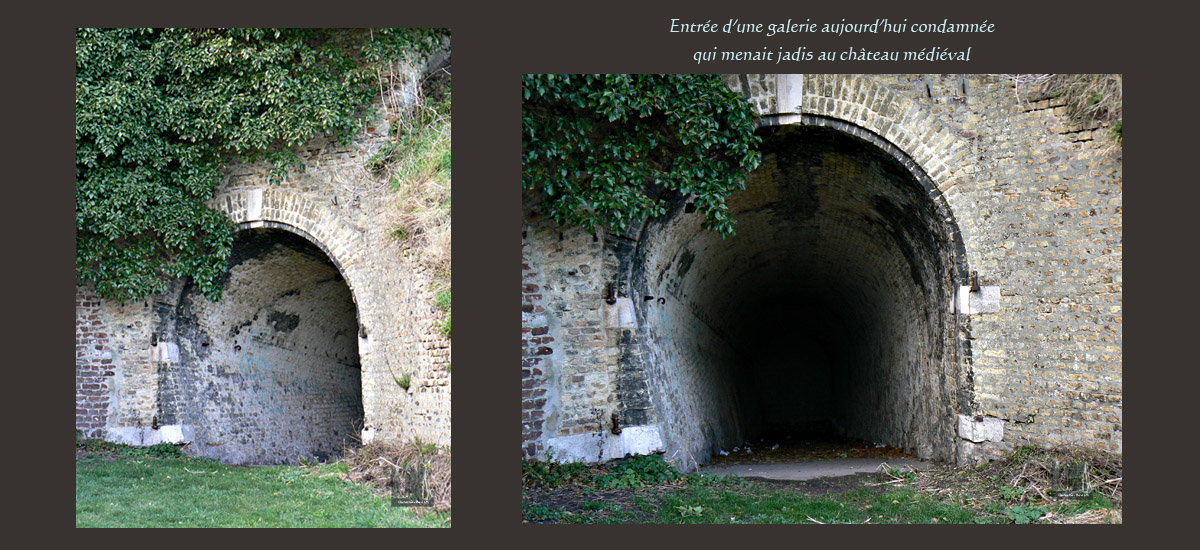
→ Rise and Fall of the castle...
The Hurepel Philippe Earl dies from 1234. The castle then returns to King Louis IX, then the counts of Artois ... It was under British occupation (1347-1557), it will host a large number of nobles and become at once a resort, power and a major state prison.
Edward III, after the capture of Calais, resides there for a month. From 9 to 27 October 1360, Edward, Prince of Wales, and Charles, Dauphin of France staying there to renegotiate the terms of the release of King John II. They amend and ratify the treaty of Brétigny of 8 May 1360. At a Mass celebrated at St. Nicolas, located near the castle in a neighborhood increasingly bourgeois, the two lords swear on the Holy Gospels strict adherence to the treaty.
In the fifteenth century the English sovereigns succeed in Calais: Henry V, Henry VI, Henry VII ...
During the so-called English Civil War of the Roses (1455-1485) that opposed the royal house of Lancaster in the House of York, the Earl of Warwick Castle weapon and supports the Duke of York ...
During the British occupation, the fortifications of Calais were strengthened. An enclosure of forty round towers to the south and north squares around the city. But these new fortifications went still be insufficient ...
In 1558, the castle was besieged by the Duke of Guise and taken to the English. The kings of France then decided to transform the site into large fortress capable of resisting invasions from England and the Spanish Netherlands...
Adapting to new fortifications arms
→ The appearance of the bastion fortifications Spanish Netherlands
The art of war and to protect themselves profoundly evolved over two centuries of English occupation which makes the castle obsolete. The use of guns is spreading. The projectiles bronze and wrought iron replace traditional stone arrows and bullets that explode on impact. The pace of guns accelerates, which facilitates the creation of holes in the walls. Consequence: new military engineers will look into the art of conducting what is now considered an artillery duel.
Military engineers, as Girolamo Maggi (1523-1572) and Giacomo Castriotto (1510-1563) in his work "Delle Fortificazione della città", will develop the art of fortifying a city. We will recommend to lower the height of the towers and curtain who lose their slots in favor of embrasures for guns. Multiply the works around the main body of the fortress to delay the attack against the fortress itself, and that, by ensuring that the enemy can not find refuge. It caponiers landscape in ditches…
In 1560, King Francis II decided to raze the castle to build the new citadel. The castle is however only partially and gradually dismantled as part of its towers and its walls is built first with new fortifications (including Paved Tower and the square tower). Two military engineers, Giacomo Castriotto Jean EVRARD and Bar le Duc (1554-1610) were appointed to oversee the work.
Soldiers and convicts sentenced to hard labor work on the fortifications. To give full scope to the fort, one shaves the most beautiful area of the city which housed the English lords. In August 1561, the Saint Nicolas church is also destroyed. In 1605, we will erect a chapel of the same name in her memory.
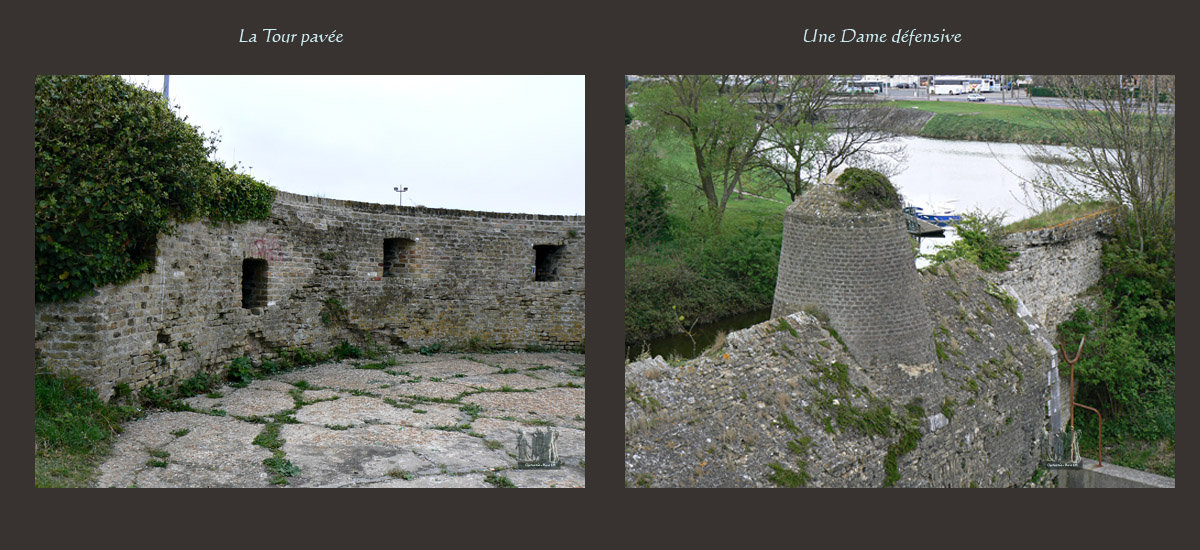
THE PAVED TOUR :
With the square tower ( "Marshall's tower"), it is one of the last tours of medieval times. It was concreted by the Germans to install their arsenal.
THE RAM :
This system barricade conical was added to protect the cofferdams considered a sensitive point of the defensive system.
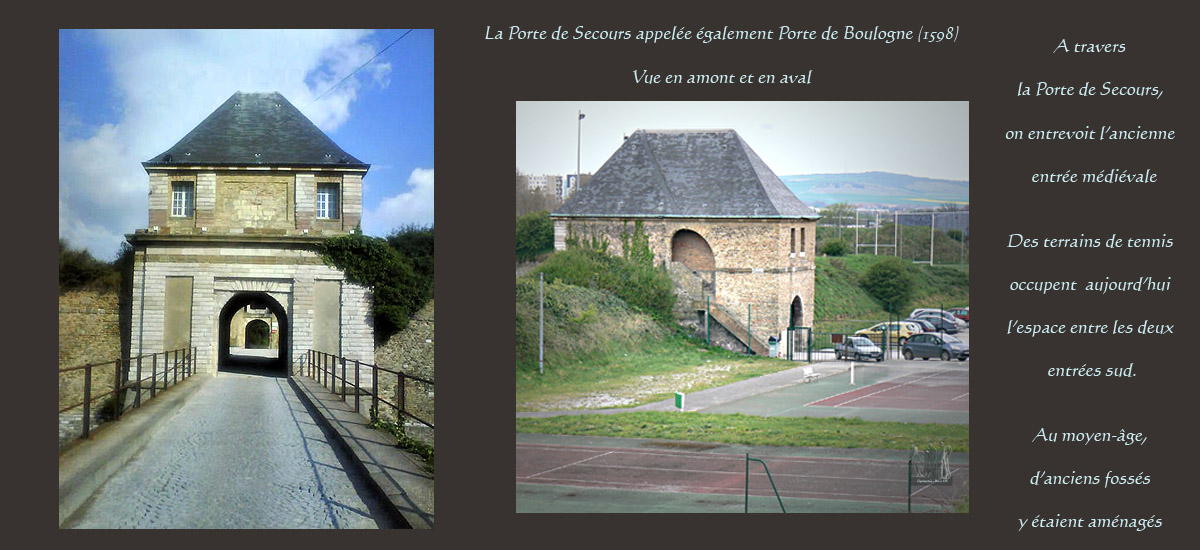

STELE NEPTUNE IN THE EAST FRONTON (1633) :
She was found in the Garennes, east of the city, in 1600 and probably dates from the British occupation. This Neptune lies and holds in one hand his trident, put the left arm on an urn from which emerge in the waters three lilies.
→ The walls to the test of the Spanish conquest
January 15, 1595, Henry declared war on Philip II of Spain and son of Charles Quint. He hopes to end territorial aspirations of Spain, which then has the 17 provinces of the Netherlands, which then included modern Belgium. April 23, 1596, the troops of the Archduke Albert of Austria, governor of Flanders and the head of the army of the Netherlands, arrived at Calais, attack the northeast bastion of the Citadel.
Despite strong resistance organized by Michel Patras Campaigno (1553 - 1597), nicknamed the Black Knight, Captain of the garrison of Calais, a hole is drilled and Spaniards make the owners. The Calaisiens, who had taken refuge there after the strong and the strong Risban Nieulay were taken, are there in large part massacred. The city is also looted. It will remain Spanish until the Treaty of Vervins signed in 1598 between France and Spain.
→ The climax of bastion fortifications in the seventeenth century
After the reconquest of Calais, development works are undertaken. It reinforces the northeast entrance of the Citadel: Jean Evrard of Bar le Duc, regarded in France as the father of the bastion fortifications are built halfpipe Hermitage (see photo top).
In 1632, Louis XIII and Cardinal Richelieu decided to transform the Citadel into Dockyard. They are constructing different buildings to store weapons and three underground to house troops during the offensive. We built the Gate of Neptune (1633), the magazine (1638) ... A column with the Richelieu bust was erected in the courtyard of the arsenal. Many Calaisiens contribute to the work followed by the Marquis de Saint Chamond, Lieutenant General of the King's armies. In 1689, the Marquis de Vauban transformed the ruins of the castle bastions.
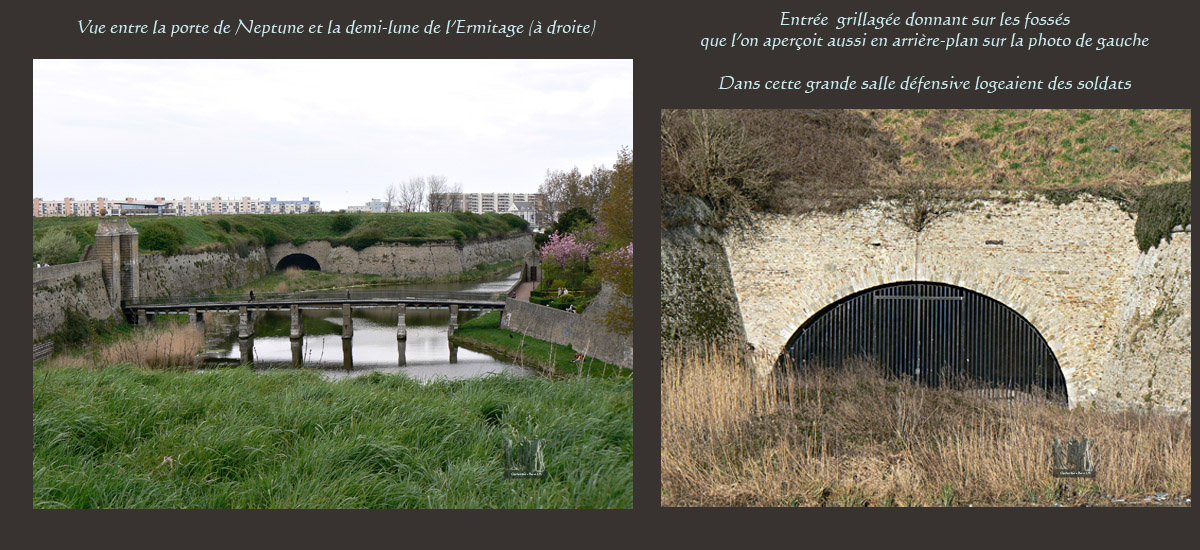
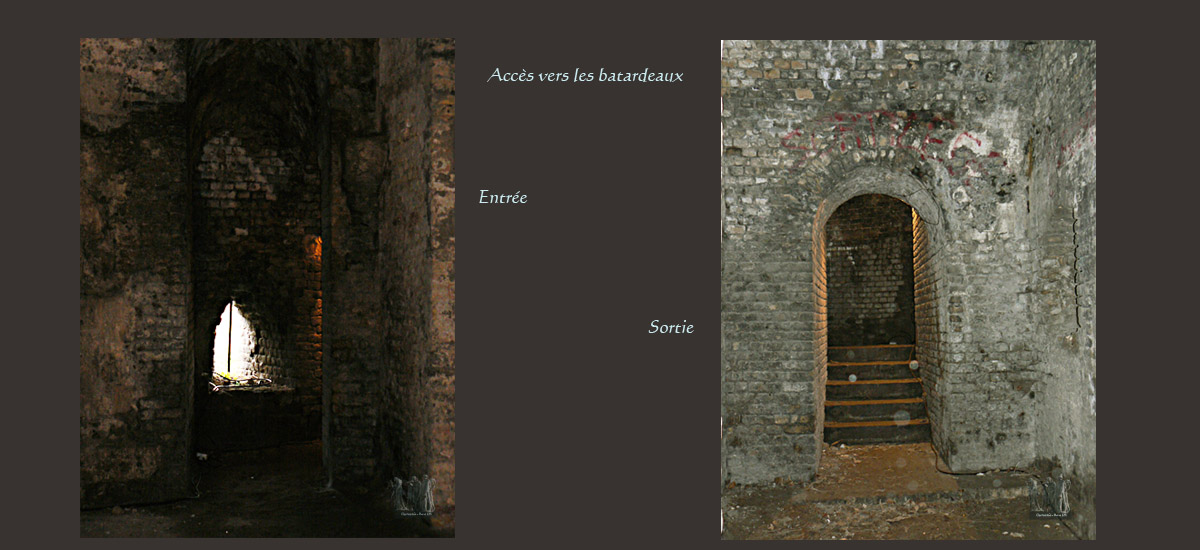
THE COFFERDAMS
These small galleries at the end of the stables held the waters of the moat, which amounted to more than two meters from their current level. The goal was to makethe jump to flood the citadel when needed in battle. Here they were never used.

An arsenal until after the Second World War
In the early nineteenth century, restoration work is undertaken to house in the best possible conditions a garrison of the French army garrison which will remain until the Second World War. A large barracks is home to over a thousand men, powder magazines, two cisterns, stables ... The southern wall is lined landscape and stables ...
Thus, throughout the history of Calais during the Second World War, the Citadel site was the scene of bloody battles and multiple ...
In fact, during the month of May 1940, the German heavy artillery fire bombs multiplies 100 and 500kg causing the collapse of the barracks, fire stables with horses ... The flamethrower belching fire through breaches, galleries ... May 25, a German officer say, "the Citadel has not rendered, it was conquered with weapons in hand. "The buildings - all damaged or destroyed - will be demolished at the end of the war. Until the last days of the war, the Citadel was the place of tragedies. And a small discreet monument, near the south entrance, and commemorates the execution of young people of Calais in 1944, convicted of sabotaging the Courtaulds factory. A few weeks later, Calais was released.

THE POUDRIÈRE:
It was used to store barrels of gunpowder. At its base, orifices open to the air shaft. Barrels rested on a raised floor to optimize the ventilation system and keep the well dry powder. Basically, a top port is connected to an external ventilation, small windows open onto the corridors surrounding the room.
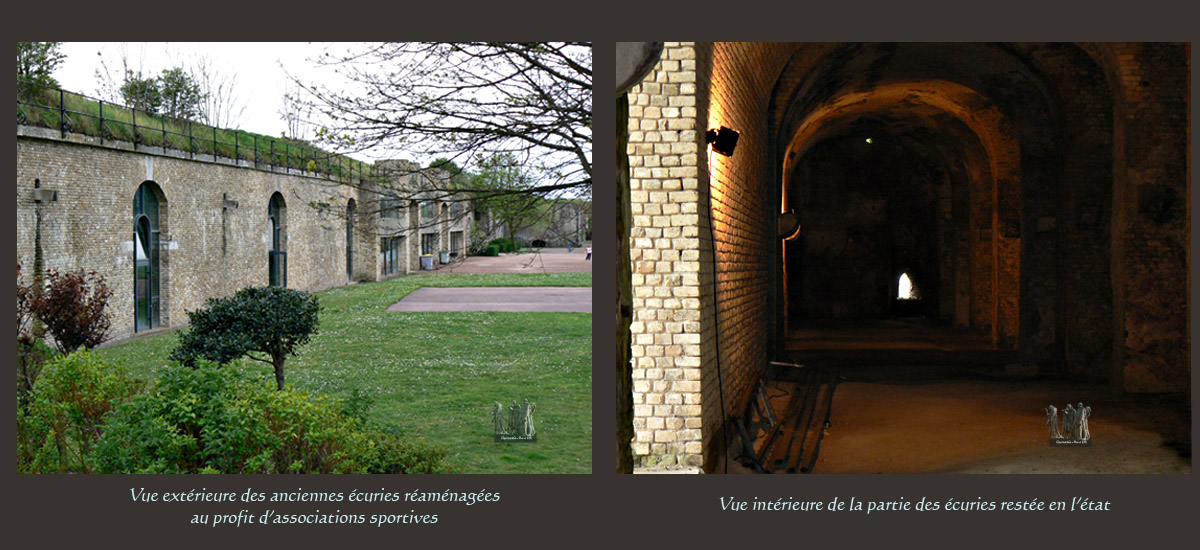
STABLES :
Today, they are partly used by sports clubs and the Chess Club of Calais. The lower level housed the horses, while dormitories men occupied the top level, now disappeared.

Glossary fortifications
AN ARSENAL:
Place of deposit of weapons and ammunition.
A BASTION:
fortification projecting from the walls of a fortress. These protruding angles are supported by walls, grass or clay. It consists of faces and flanks defending themselves so as to shoot the assailant whatever its attack position.
A CAPONIER :
Road or dwelling dug into the bottom of a dry ditch a strong place to put soldiers under cover.
A CASEMATE:
Shelter buried underground vaulted to bombproof.
ONE STATION:
Building for the housing of troops.
ROUND ONE WAY:
Location set around a castle, or a fortress at the top of the fortifications. Way between the wall and the wall of a fortress.
A CITADEL:
castle or fortress that commands a city.
ORDER A CITY:
Dominate a city by its elevation and possibly control access.
A COURTINE:
straight wall between two bastions.
A NICHE :
Opening at regular intervals on top of a tower or a curtain, which served for defense. This word can designate more specifically the opening of a trench parapet, a wall to aim and shoot.
A WATCHTOWER :
Sentry box of wood or stone raised houses where a sentry. Placed overhanging the corners of castles, bastions, she assured the surrounding area.
RECESSES OF :
Opening in a parapet where it points the gun to shoot the enemy.
FORTIFICATIONS OF:
defense structure, or set of books that students around a city to defend against the companies of the enemy.
A GLAZE:
inclined Ttalus which extends in front of a fortification.
A MERLON:
solid part of a parapet between two slots or two doorways.
A DEADLY:
Opening vertical slot in the walls of a fortress and by which we can throw projectiles or to get covered on the attackers or assailants.
A BOOK TO HORNS:
outwork fortified outside the body of the place, and consists of two half-bastions, joined by a curtain wall and closed on both sides by two wings parallel to each other.
A PARAPET:
Upper part of a shield that covers and protects the defenders and over which they fire.
A POTERNE:
backdoor (false door, underground gallery) usually placed in the corner of the sidewall and the curtain for secret exits through the gap.
A REDOUTE :
fortification fully closed and detached, or single quadrangle bounded by a berm of approximately two meters in height where we could put the guns.
A RAMPART :
Originally, the term simply meant the wall in full masonry that surrounded and protected a town or castle. Subsequently, the term has designated the speaker further garnished with bastions and curtain walls, surrounded by a moat and pierced with doors and posterns ... Unlike MURAILLES, it is often reinforced earth ...
BASE "talutée":
lower part slightly inclined and thicker in solidly sit a book.
A SAPE:
Work done underground to overthrow a wall, a tower, etc.